The blue-banded pitta
อัญมณี แห่งบอร์เนียว
The most beautiful Pitta Birds of Borneo the Blue Banded Pitta. This pitta is endemic to the Borneo Island, rare and most jewelleries
Day1
กรุงเทพ-โคตาคินาบาลู
สายการบิน Malaysia Airlines 5:40-13.55 trip.com 8550 THB ( round trip)
Tranfer ที่ KL 2hr 20 mins 8.55-11.15
ถึงสนามบิน ติดต่อรถเช่า ค่าเช่ารถอยู่ที่ประมาณวันละ 730.- บาท
เช่าที่ร้าน www.grendlinetravel.comLeely Garden Valley Lodge Tambunan
Rafflesia Information Centre
|
Crocker Range National Park
Established in 1984, the Crocker Range National Park boasts an area of 139,919 hectares, making it the largest park in Sabah. It is not only classified as a national park, but also recognised as a UNESCO Biosphere Reserve.
With its diversity of rare and endemic species of plants and wildlife from its lowland tropical forest to the higher montane forest, the park is certainly every nature and outdoor lover’s paradise.
Bird watchers would be thrilled to know that the park is also a premium birding spot, boasting a list of magnificent unique birds, including Asian paradise flycatchers, buff-rumped woodpeckers, bulbuls, hornbills, pacific swallows and chestnut munia.
อุทยานแห่งชาติ Crocker Range ก่อตั้งขึ้นในปี 1984 มีพื้นที่ 139,919 เฮกตาร์ ทำให้เป็นสวนสาธารณะที่ใหญ่ที่สุดในซาบาห์ ไม่เพียงแต่จัดเป็นอุทยานแห่งชาติเท่านั้น แต่ยังได้รับการยอมรับว่าเป็นเขตสงวนชีวมณฑลของ UNESCO
ด้วยความหลากหลายของพันธุ์พืชและสัตว์ป่าหายากและเฉพาะถิ่นตั้งแต่ป่าเขตร้อนที่ลุ่มไปจนถึงป่าดิบเขา อุทยานแห่งนี้จึงเป็นสวรรค์ของคนรักธรรมชาติและกิจกรรมกลางแจ้งอย่างแน่นอน
นักดูนกจะรู้สึกตื่นเต้นที่ได้รู้ว่าอุทยานแห่งนี้ยังเป็นสถานที่ดูนกระดับพรีเมียมอีกด้วย โดยมีนกสวยงามที่มีเอกลักษณ์เฉพาะตัวมากมาย เช่น Asian paradise flycatchers, buff-rumped woodpeckers, bulbuls, hornbills, pacific swallows and chestnut munia.Gunung Alab Substation, Crocker Range Park
 |
| The welcome sign to Gunung Alab Substation and the powerplant located at 1600 meters above sea level. |

มาดูรีวิวของคุณ
Pierre de Chabannes
Pierre de Chabannes
Founder, Pierre Wildlife
The Borneo chronicles – Partridge quest at Gunung Alab
Borneo is probably my favorite place to be on earth. It just has a special flavor, a special atmosphere that I haven’t found anywhere else. When I am setting foot in Kota Kinabalu, everything vibrates in a different way, making me feel at home but, at the same time, giving me an amazing sensation of building excitation and mystery. The forests of Borneo, to this day, stand as being some of the most diverse in the world and the fauna of Borneo is seen worldwide as being one of the world’s most unique and exciting.
เกาะบอร์เนียวน่าจะเป็นสถานที่โปรดของฉันบนโลกนี้ แค่มีรสชาติพิเศษบรรยากาศพิเศษที่หาไม่ได้จากที่อื่น เมื่อฉันก้าวเท้าไปที่โคตาคินาบาลู ทุกอย่างจะสั่นสะเทือนไปในทิศทางที่แตกต่างออกไป ทำให้ฉันรู้สึกเหมือนอยู่บ้าน แต่ในขณะเดียวกันก็ให้ความรู้สึกที่น่าตื่นตาตื่นใจในการสร้างความตื่นเต้นและความลึกลับ จนถึงทุกวันนี้ ป่าของเกาะบอร์เนียวถือเป็นป่าที่มีความหลากหลายมากที่สุดในโลก และสัตว์ต่างๆ ในเกาะบอร์เนียวก็ถูกมองว่าทั่วโลกเป็นหนึ่งในป่าที่มีเอกลักษณ์และน่าตื่นเต้นที่สุดแห่งหนึ่งของโลก
I feel so lucky to be able to visit Borneo (at least the Malaysian state of Sabah) on a regular basis and to have made good friends there, both amongst conservation researchers, zoologists and local everyday people. There are so many places to go to see endemic animals on this island and in Sabah alone but, if you truly want to experience what Borneo is about, you should aim for the mountains ! Near Kota Kinabalu lies the Crocker Range. Located within 90 minutes of driving, this mountain range is still home to lots of endemic animals and plants even if deforestation has been particularly intense in this area, for agriculture.
ฉันรู้สึกโชคดีมากที่ได้ไปเยือนเกาะบอร์เนียว (อย่างน้อยก็รัฐซาบาห์ของมาเลเซีย) เป็นประจำ และได้รู้จักเพื่อนที่ดีที่นั่น ทั้งในหมู่นักวิจัยด้านการอนุรักษ์ นักสัตววิทยา และผู้คนในท้องถิ่นทุกวัน มีสถานที่มากมายให้ไปดูสัตว์ประจำถิ่นบนเกาะแห่งนี้แม้ในซาบาห์เพียงแห่งเดียว แต่ถ้าคุณต้องการสัมผัสประสบการณ์เกี่ยวกับเกาะบอร์เนียวจริงๆ คุณควรมุ่งเป้าไปที่ภูเขา ! ใกล้โคตาคินาบาลูมีเทือกเขาคร็อกเกอร์ เทือกเขานี้ใช้เวลาขับรถเพียง 90 นาที ยังคงเป็นที่อยู่ของสัตว์และพืชเฉพาะถิ่นจำนวนมาก แม้ว่าการตัดไม้ทำลายป่าจะรุนแรงเป็นพิเศษในพื้นที่นี้เพื่อการเกษตรก็ตาม
 |
| Gunung Alab is also a great site to photograph Bornean endemic orchid species such as Dendrobium lambii |
Having damaged my left knee in the Philippines, I had to pass on going back to Mt Kinabalu with a heavy heart but I was told by local guides that the hike to Gunung Alab’s main birding site isn’t that hard so I chose to give it a try. The main and biggest target of my stay on Borneo was the beautiful mountain endemic Crimson-headed partridge (Haematortyx sanguiniceps). This dimorphic partridge species is, like I just said, endemic to the mountain forests of northern Borneo. Although it isn’t particularly scared of humans in protected areas of its range, it remains globally difficult to photograph as it rarely comes in the open. I had seen the species twice around Mt Kinabalu but never got an open-shot possibility. Gunung Alab is also a good spot to see other Bornean mountain endemics such as the Red-breasted partridge (Arborophila hyperythra) or the Golden-naped barbet (Psilopogon pulcherrimus). I didn’t see the first and got only very brief view of the later but this is only the beginning of my story with Gunung Alab ! I am definitely going back there to document more wildlife and stay longer (possibly even at night if the substation’s accomodations open again).
ประวัติของฉันกับ Gunung Alab ย้อนกลับไปในปี 2016 เมื่อฉันขอให้คนขับรถพาฉันไปที่ฟาร์มผีเสื้อ Kipandi ฉันไม่พบใครที่รู้เกี่ยวกับสถานที่นั้น แต่ชื่อ "Kipandi" ฉันกระตุ้นความจำให้คนขับรถของฉัน และเขาก็ขับรถพาฉันขึ้นไปบนภูเขา ซึ่งเราได้พบกับฟาร์มผีเสื้อและกล้วยไม้ (น่าเสียดายที่ตอนนี้ปิดให้บริการแล้ว) ในเวลานี้ฉันไม่รู้เลยว่าห่างออกไปเพียงไม่กี่นาที หากเราขับรถขึ้นเนินต่อไป ฉันคงจะได้พบพื้นที่ป่าอันน่าทึ่งที่ซึ่งนกประจำถิ่นของเกาะบอร์เนียวหลายชนิด (เช่น ไก่ฟ้าบุลเวอร์ และไก่ฟ้าบอร์เนียวอาร์กัส) สามารถ สามารถพบได้ สวรรค์แห่งนี้อยู่ใกล้กับบริเวณยอดเขา Gunung Alab (ภาษาอังกฤษเรียกว่า Mt Alab) ถนนที่เป็นหลุมเป็นบ่อทอดยาวไปจนถึงสถานีย่อย Gunung Alab ซึ่งเจ้าหน้าที่พิทักษ์ป่ากำลังเฝ้าดูสวนกล้วยไม้อันงดงามและที่พักนักท่องเที่ยวที่ยังคงปิดเมื่อฉันไป (อาจเป็นเพราะโควิด 19) ถนนสายนี้ทอดยาวไปจนถึงโรงไฟฟ้าที่มีเสาอากาศขนาดใหญ่ 2 เสา และพื้นที่นี้เป็นที่รู้จักกันดีในหมู่นักดูนกว่าเป็นจุดที่ดีในการชมสัตว์สายพันธุ์เฉพาะถิ่นบนภูเขาที่อาจหาได้ยากในพื้นที่อื่นๆ ที่รู้จักกันดี เช่น ภูเขาคินาบาลูอันยิ่งใหญ่
หลังจากได้รับบาดเจ็บที่เข่าซ้ายในฟิลิปปินส์ ฉันเดินทางกลับไปยังภูเขาคินาบาลูด้วยหัวใจที่หนักอึ้ง แต่ไกด์ท้องถิ่นบอกฉันว่าการเดินป่าไปยังจุดดูนกหลักของ Gunung Alab นั้นไม่ยากขนาดนั้น ฉันจึงเลือกที่จะลองทำ ดู เป้าหมายหลักและใหญ่ที่สุดในการพักเกาะบอร์เนียวของฉันคือนกกระทาหัวแดง Crimson-headed partridge (Haematortyx sanguiniceps) ซึ่งเป็นนกกระทาประจำถิ่นบนภูเขาที่สวยงาม อย่างที่ฉันบอกไปแล้วว่านกกระทาชนิดนี้มีเฉพาะถิ่นในป่าภูเขาทางตอนเหนือของเกาะบอร์เนียว แม้ว่าเค้าจะไม่กลัวมนุษย์มากนักเพราะอยู่ในพื้นที่คุ้มครอง แต่การถ่ายภาพทั่วโลกยังคงเป็นเรื่องยากเนื่องจากไม่ค่อยปรากฏในที่โล่ง ฉันเคยเห็นนกชนิดนี้มาแล้วสองครั้งรอบๆ ภูเขาคินาบาลู แต่ไม่เคยมีโอกาสได้ภาพชัดๆเลย
Gunung Alab ยังเป็นจุดที่ดีในการชมสัตว์ประจำถิ่นของภูเขาบอร์เนียวอื่นๆ เช่น นกกระทาอกแดง Red-breasted partridge (Arborophila hyperythra) หรือ Golden-naped barbet (Psilopogon pulcherrimus) ฉันไม่ได้เห็นในครั้งแรกและต่อมาได้เพียงมุมมองสั้นๆ ในภายหลัง แต่นี่เป็นเพียงจุดเริ่มต้นของเรื่องราวของฉันกับ Gunung Alab เท่านั้น! ฉันจะกลับไปที่นั่นอย่างแน่นอนเพื่อบันทึกเรื่องราวเกี่ยวกับสัตว์ป่ามากขึ้นและอยู่ให้นานขึ้น (อาจเป็นตอนกลางคืนด้วยซ้ำหากที่พักของสถานีย่อยเปิดอีกครั้ง)
 |
The high-altitude forest in Gunung Alab is composed of large stands of bamboo. This area is one of the best to observe partridges and the extraordinary Bulwer’s pheasant. |
ขณะที่ฉันกำลังดูนกรอบๆ พื้นที่ของ Gunung Alab ฉันก็มองหาแมลงและผีเสื้อโดยเฉพาะด้วย แม้ว่าฉันจะเห็นผีเสื้อบางตัว แต่ฉันแทบไม่มีโอกาสได้ถ่ายรูปดีๆ เลยเพราะลมแรงมาก ดังนั้นการค้นหาสัตว์ไม่มีกระดูกสันหลังของฉันจึงจำกัดอยู่แค่คริกเก็ตสองสามสายพันธุ์ (Nisitrus vittatus และ Nisitrus musicus ตามลำดับ) ซึ่งเป็นคู่ผสมพันธุ์ของ แมลงเต่าทอง (Chrysolina kinabaluensis) กิ้งกือแทรคเตอร์ที่ไม่ปรากฏชื่อ และแมงมุมสวนผลไม้แถบดำจำนวนมาก (Leucauge celebesiana)ลมหนาวยังขัดขวางสัตว์อื่นๆ ส่วนใหญ่ไม่ให้ปรากฏตัวในเช้าวันนั้น แต่ถึงกระนั้น ฉันก็โชคดีที่ได้พบเห็นนกจับแมลง Rufous-chested flycatchers (Ficedula dumetoria muelleri) คู่สวยงามของนกจับแมลง Snowy-browed flycatcher (Ficedula hyperythra sumatrana) และนกเด้าลมสีเทา Grey wagtailsอพยพสองสามตัว (Motacilla cinerea cinerea)
 |
| This beautiful male Snowy-browed flycatcher (Ficedula hyperythra sumatrana) stole the show ! I never had an opportunity to see this exquisite but so small species from this close ! |
It took me three hours of waiting patiently in the cold, repelling a few wasps, to finally hit my main target ! The pair of Crimson-headed partridges that live nearby finally came over to investigate the area for food, giving me more than 30 minutes of unobstructed views of both sexes. The male has vibrant colors and the female is duller but still has bright red tail feathers. I was even lucky to hear the male call from close and I was very surprised at how loud the call actually is.
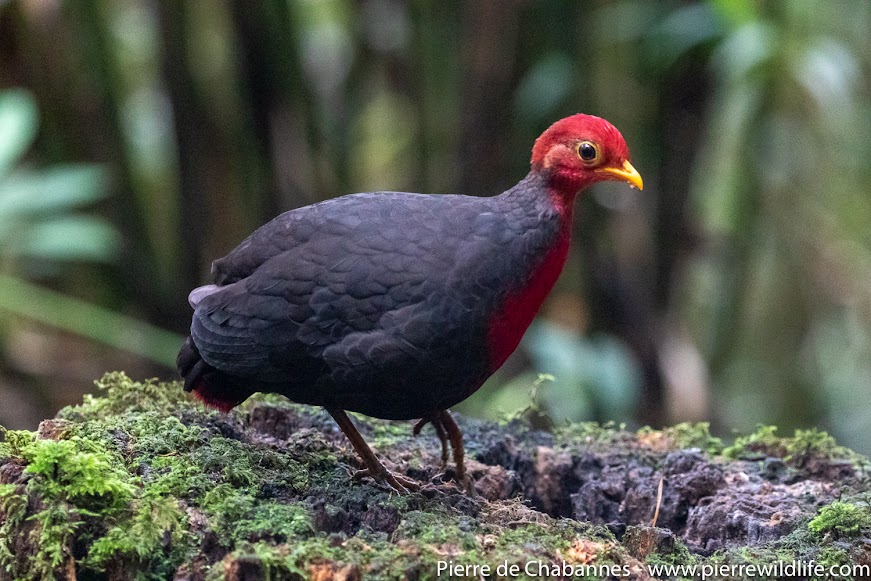 |
| At last, today’s target appears ! The colors of the male Crimson-headed partridge (Haematortyx sanguiniceps) are so vibrant ! |
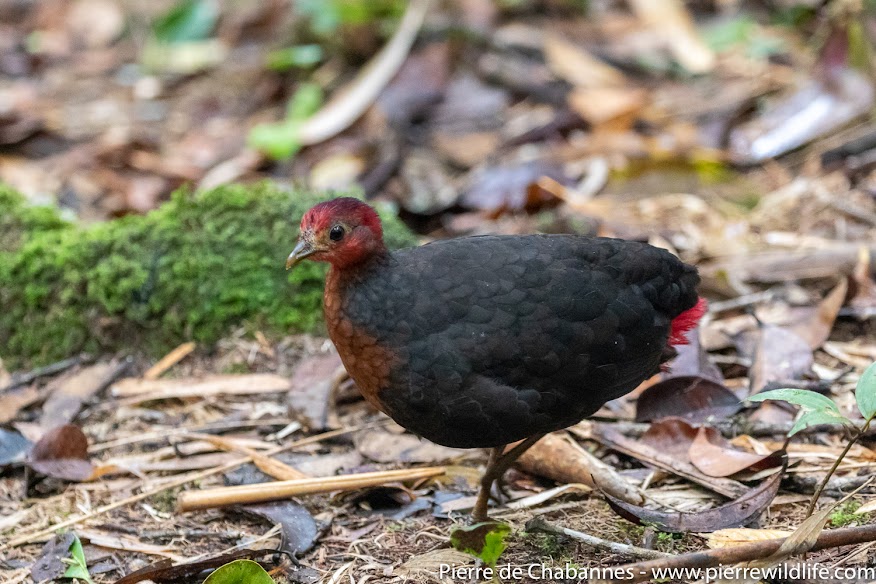 |
| Although less colorful, the female Crimson-headed partridge is still beautiful ! Look at the brightness of her red tail feathers ! |
ฉันใช้เวลาสามชั่วโมงในการรอคอยอย่างอดทนท่ามกลางความหนาวเย็น ขับไล่ตัวต่อไม่กี่ตัว ในที่สุดก็ถึงเป้าหมายหลักของฉัน ! นกกระทาหัวแดงคู่ที่อาศัยอยู่ใกล้ ๆ ในที่สุดก็เข้ามาสำรวจพื้นที่เพื่อหาอาหาร ทำให้ฉันมีเวลามากกว่า 30 นาทีในการชมทั้งสองเพศอย่างไม่มีอะไรมาบดบัง ตัวผู้มีสีสันสดใส ส่วนตัวเมียมีสีเข้มกว่าแต่ยังคงมีขนหางสีแดงสด ฉันโชคดีมากที่ได้ยินเสียงผู้ชายโทรมาใกล้ๆ และฉันก็แปลกใจมากที่เสียงนั้นดังจริงๆ
แต่นี่ไม่ใช่ไฮไลท์เพียงอย่างเดียวของวัน เนื่องจากการเดินทางไป Gunung Alab ยังทำให้ฉันได้เห็นทิวทัศน์ยามเช้าของนก Sunda laughingthrush ชนิดย่อยบอร์เนียว (Garrulax palliatus schistochlamys) และ Treacher’s laughingthrush (Pterorhinus treacheri) ประจำถิ่นที่ดูเหมือนจะ จะค้นหาได้ง่ายกว่าในภูเขาคินาบาลู สัตว์เฉพาะถิ่นบนภูเขาอื่นๆ เช่น White-throated fantail (Rhipidura albicollis kinabalu) และแม้แต่นกพญาปากกว้าง Whitehead’s broadbill (Calyptomena whiteheadi) ก็พบเห็นได้ในพื้นที่นี้แล้วสัตว์เลี้ยงลูกด้วยนมล่ะ? คือ… ต้องบอกว่าไม่ได้เจอเยอะนะ แต่ในกรณีนี้คุณภาพย่อมดีกว่าปริมาณเสมอ ! เมื่อฉันไปถึงจุดดูนกในตอนเช้า ฉันสังเกตเห็นสิ่งที่มองมาแต่ไกลเหมือน กระแต tree shrew. หลังจากเฝ้าดูอยู่สองสามชั่วโมง ในที่สุดฉันก็ได้รับโอกาสดีๆ ให้ถ่ายรูป ฉันคาดหวังว่าจะต้องประสบปัญหาในการระบุตัวตนจริงๆ เนื่องจากพวกตระกูลtree shrewนั้นยากต่อการแยกแยะ โดยเฉพาะอย่างยิ่งบนเกาะบอร์เนียวซึ่งมีสัตว์หลายชนิดที่พบได้บนเกาะ แต่สัตว์ตัวนี้ดูไม่เหมือน tree shrewเลยจริงๆ เมื่อในที่สุดฉันก็ได้พิจารณาภาพถ่ายของฉันอย่างใกล้ชิด ฉันรู้ว่ามันเป็นกระรอกสายพันธุ์ที่ฉันไม่เคยเห็นมาก่อน และด้วยความตื่นเต้นของฉัน มันกลายเป็นกระรอกประจำถิ่นของภูเขาบอร์เนียว : กระรอกดินบนภูเขาบอร์เนียว the Bornean mountain ground squirrel
(Sundasciurus everetti) !
 |
| Squirrels can be quite shy and difficult to photograph but this Bornean mountain ground squirrel (Sundasciurus everetti) was really curious and allowed me to get very nice photos ! |
While walking my way down, hoping to finally see some butterflies, my attention got caught by movement in the tall ferns that were abundant on the path’s sides. I could hear chirping and even fairly loud calls at some time but the birds remained unvisible for several minutes until I could finally locate the little critter ! After nearly an hour of “hunting”, I finally managed to grab one “OK” shot of what turned out to be a really skulking species, the Aberrant bush-warbler (Horornis flavolivaceus banksi) !
 |
| The skulker has finally been seen ! Meet the cute but very shy Aberrant bush-warbler (Horornis flavolivaceus banksi) ! |
As said in the introduction, I am definitely counting to go back for a longer time in the hopes of documenting many more species from the area, hike longer and get an even better glimpse at the biodiversity of Gunung Alab ! This will be for the end of 2023 if all goes well !
The male Crimson-headed partridge treated me with displays and very loud calls !
Until then, take care !
Pierre de Chabannes
Founder, Pierre Wildlife
Bird Hide at Mt.Alab& Trus Madi
 |
| The crimson-headed partridge is a species of bird in the pheasant |
 |
| Crested Partridge |
Day2-3
29-30 Mar 2024
Kinabalu ParkKinabalu Park is situated on the Crocker Range on the western coast of Sabah. It is located within the district of Ranau, within the West Coast Division. The park is not to be confused with Crocker Range National Park which is a separate park in the south.
The park headquarters is 88 kilometres away from the city of Kota Kinabalu. There are sealed roads leading towards the park headquarters from other parts of Sabah. It is situated on the southern boundary of Kinabalu Park, at an elevation of 1,563 m (5,128 ft).
This park is administered by an organisation called Sabah Parks. Accommodations in the form of chalets can be found in the park, mostly around the headquarters. Reservations for accommodation and mountain climbing guides are processed through Sutera Sanctuary Lodges, a private company. Every person who wishes to climb the mountain must be accompanied by a qualified guide. Sutera is now requiring hikers to stay one night at their lodge near the entrance, in addition to a required stay at Laban Rata. The cost to stay is considerably higher than at lodging just outside the park and includes a mandatory purchase of meals, etc.
The mountain summit trail begins at Timpohon. There is also an alternative route called the Mesilau Trail.
A notable feature of the park is Low's Gully. It is a 1.6-kilometer deep ravine stretching 10 kilometres on the side of the mountain peak.
อุทยานคินาบาลูตั้งอยู่บนเทือกเขาคร็อกเกอร์ทางชายฝั่งตะวันตกของซาบาห์ ตั้งอยู่ในเขต Ranau ภายในเขตชายฝั่งตะวันตก อุทยานแห่งนี้อย่าสับสนกับอุทยานแห่งชาติคร็อกเกอร์เรนจ์ซึ่งเป็นอุทยานที่แยกจากกันทางตอนใต้
สำนักงานใหญ่อุทยานอยู่ห่างจากเมืองโคตาคินาบาลู 88 กิโลเมตร มีถนนปิดซึ่งนำไปสู่ที่ทำการอุทยานจากส่วนอื่นๆ ของซาบาห์ ที่ทำการนี้ตั้งอยู่บนขอบเขตด้านใต้ของอุทยานคินาบาลู ที่ระดับความสูง 1,563 ม. (5,128 ฟุต)อุทยานแห่งนี้บริหารงานโดยองค์กรชื่อ Sabah Parks ที่พักในรูปแบบของกระท่อมสามารถพบได้ในสวนสาธารณะ โดยส่วนใหญ่อยู่รอบๆ สำนักงานใหญ่ การสำรองที่พักและไกด์ปีนเขาจะดำเนินการผ่าน Sutera Sanctuary Lodges ซึ่งเป็นบริษัทเอกชน ทุกคนที่ประสงค์จะปีนภูเขาจะต้องมีไกด์ที่มีคุณสมบัติเหมาะสมคอยดูแล ขณะนี้ Sutera กำหนดให้นักเดินป่าต้องพักหนึ่งคืนในบ้านพักใกล้ทางเข้า นอกเหนือจากการเข้าพักที่ Laban Rata ค่าเข้าพักนั้นสูงกว่าค่าที่พักที่อยู่นอกสวนสาธารณะอย่างมาก และรวมค่าอาหารที่ต้องซื้อไว้ด้วย ฯลฯ
เส้นทางเดินขึ้นยอดเขาเริ่มต้นที่ ทิมโปฮอน นอกจากนี้ยังมีเส้นทางอื่นที่เรียกว่า Mesilau Trail
ลักษณะเด่นของอุทยานคือ Low's Gully เป็นหุบเขาลึก 1.6 กิโลเมตร ทอดยาว 10 กิโลเมตร ทางด้านยอดเขา
จากเมืองโคตาคินาบาลู นักท่องเที่ยวสามารถนั่งรถมินิบัสหรือแท็กซี่จากสถานีขนส่ง Jalan Padang ซึ่งมีเส้นทางไปยัง Kundasang/Ranau ติดต่อกับคนขับเพื่อไปส่งที่เมือง Ranau จากนั้นเป็นต้นไป นักท่องเที่ยวจะต้องเช่ารถส่วนตัว หรือคุณสามารถขับรถเอง ใช้บริการ e-hailing จากเมืองโคตาคินาบาลู หรือสอบถามกับบริษัททัวร์ที่เลือกเพื่อเพิ่มการเดินทางครั้งนี้
ต่อไปนี้เป็นรีวิว ทริปดูนกด้วยตัวเอง Posted by Matthew Kwan
เรานั่งเครื่องไฟลท์เช้าไปโคตาคินาบาลูในวันอาทิตย์ ทุกอย่างเป็นไปอย่างราบรื่น เราเช่ารถกับ Easy-Rent A Car อีกครั้ง พนักงานของพวกเขารอเราอยู่ที่โถงผู้โดยสารขาเข้า ฉันอยากแนะนำพวกเขาเป็นอย่างยิ่งสำหรับทุกคนที่จะมาเยือนซาบาห์ พนักงานสุภาพและช่วยเหลือดี และโดยปกติแล้วรถจะอยู่ในสภาพดี เราวางแผนจะให้ถึงถนนก่อนบ่าย 2 โมง การขับรถขึ้นไปยังสำนักงานใหญ่ Kinabalu Park เส้นทางตรงและง่ายดาย เรามาถึงโรงแรมของเราประมาณ 15.30 นWe stayed at the Ayana Holiday Resort, a decent little hotel just few minutes drive from the park HQ. Once we dropped our luggage we drove straight to park entrance, entrance fee for non-Malayan visitor is 15RM. Our first stop was around Liwagu Restaurant, an area I’ve always found to be quite productive for common species. Sure enough a flock of Black-capped White-eyes made an appearance.
เราพักที่อายานา ฮอลิเดย์ รีสอร์ท ซึ่งเป็นโรงแรมเล็กๆ ที่ดี ห่างจากที่ทำการสวนสาธารณะเพียงไม่กี่นาที เมื่อเราฝากสัมภาระแล้ว เราก็ขับรถตรงไปยังทางเข้าสวนสาธารณะ ค่าเข้าสำหรับผู้ที่ไม่ใช่ชาวมาเลย์คือ 15 RM จุดแรกของเราคือบริเวณร้านอาหาร Liwagu ซึ่งเป็นพื้นที่ที่ฉันพบว่าค่อนข้างมีประสิทธิผลสำหรับนกสายพันธุ์ทั่วไป แน่นอนว่ามีฝูงนกตาขาวที่มีหมวกดำปรากฏตัวให้เห็นThings were surprisingly quiet, with only a few birds seen well, the common Indigo Flycatcher were amongst the most ‘showy’. Other birds seen well included a Sunda Cuckooshrike and Bornean Whistlers. We had dinner at the Liwagu Restaurant before heading back to our hotel, where we heard Mountain Scops Owl in the distance.
สิ่งต่างๆ เงียบสงบอย่างน่าประหลาดใจ โดยมีนกเพียงไม่กี่ตัวที่มองเห็น common Indigo Flycatcher เป็นหนึ่งในนกที่ 'ฉูดฉาด' ที่สุด (เจอที่บอร์เนียวและสุมาตรา)นกอื่นๆ ที่เห็นได้แก่ Sunda Cuckooshrike และ Bornean Whistlers เราทานอาหารเย็นที่ร้านอาหาร Liwagu ก่อนที่จะมุ่งหน้ากลับโรงแรม ซึ่งเราได้ยินเสียงนกฮูก Mountain Scops อยู่ไกลๆ
 |
| Indigo Flycatcher |
Mount Kinabalu is also famous for it’s huge diversity in moths. We got a taste of it during our first evening here, with an incredible variety in colours and patterns on display. Best moths were no doubt a Sinna calospila and a Ischyja paraplesius, both incredibly beautiful.
ภูเขาคินาบาลูยังมีชื่อเสียงในด้านความหลากหลายของผีเสื้อกลางคืนอีกด้วย เราได้ลองถ่ายภาพในช่วงเย็นวันแรกที่นี่ พบว่าพวกมันมีสีสันและลวดลายที่หลากหลายอย่างไม่น่าเชื่อ ไม่ต้องสงสัยเลยว่าผีเสื้อที่ดีที่สุดคือ Sinna calospila และ Ischyja paraplesius ซึ่งทั้งคู่สวยงามอย่างไม่น่าเชื่อWe headed up to Timpohon Gate at around 5:45am and arrived just after 6am. The morning mist shrouded the gate, Bornean Treepies were the first birds that showed itself. A Maroon Woodpecker showed briefly. Back near the car park area, we spotted a Sunda Cuckoo. We tried looking for the Red-breasted Partridge calling nearby with little luck.
 |
| Bornean treepie |
เรามุ่งหน้าไปยังประตู Timpohon ประมาณ 05.45 น. และมาถึงหลัง 06.00 น. หมอกยามเช้าปกคลุมประตู นกกาแวนบอร์เนียวเป็นนกชนิดแรกที่ปรากฏตัว นกหัวขวานมารูนแสดงให้เห็นช่วงสั้นๆ เมื่อกลับมาใกล้บริเวณลานจอดรถ เราเห็น Sunda Cuckoo เราพยายามมองหานกกระทากระดุมแดงที่โชคเล็กๆได้ยินร้องอยู่ใกล้ๆ
Maroon woodpecker

Sunda cuckoo

Red breasted partridge
เมื่อหมอกปกคลุมต้นไม้ที่พลุกพล่านไปด้วยนก และ Chestnut-crested Yuhinas ก็เป็นหนึ่งในกลุ่มที่มีจำนวนมากที่สุด พวกมันอาจเป็นหนึ่งในสัตว์ประจำถิ่นบนภูเขาที่ง่ายที่สุดที่จะเห็นบนภูเขาคินาบาลู นกกระจิบอกเหลืองเหลืองก็ออกปฏิบัติการเช่นกัน ตามมาด้วยหนึ่งในสายพันธุ์ที่ดีที่สุดในตอนเช้า นกตาดำภูเขาคู่หนึ่งกำลังกินน้ำหวานของดอกไม้สีแดงริมถนน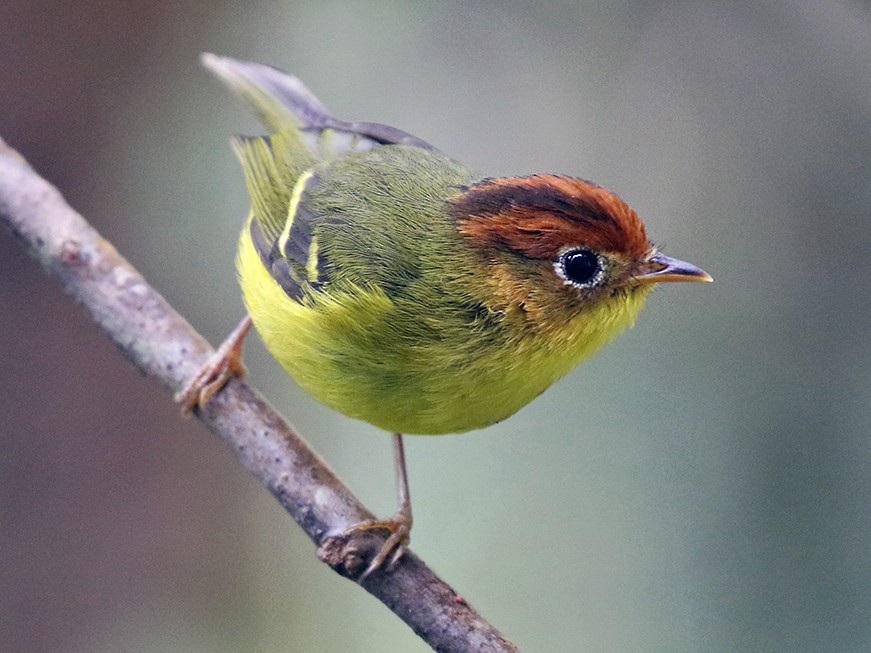 |
| Yellow breasted warbler |
 |
| Mountain Black-eye |
A very friendly Sunda Bush Warbler was also added. Blyth’s Shrike-babblers were feeding higher up the tree but gave decent views, smart looking males are always nice to see.
เพิ่ม Sunda Bush Warbler ที่เป็นมิตรมากด้วย Blyth’s Shrike-babbler กำลังหาอาหารอยู่บนต้นไม้ที่สูงขึ้นไปแต่ก็ให้มุมมองที่ดี ตัวผู้ที่สวยงามมักจะยินดีปรีดาที่ได้เห็น
We walked up to the power station to get a better look at the birds. There a male Little Pied Flycatcher and White-throated Fantail greeted us on the fence. An Ashy Drongo also hawked for insects from the fence.
เราเดินขึ้นไปที่โรงไฟฟ้าเพื่อจะได้ชมนกที่ดีมากขึ้น มีนกจับแมลงเล็กขาวดำ ลายพร้อยตัวผู้และหางขาวคอยต้อนรับเราอยู่ที่รั้ว Ashy Drongo ยังร่อนหาแมลงจากรั้วอีกด้วยHere we also saw more Chestnut-crested Yuhinas as well as many Grey-throated Minivets, both giving eye-level views. A few Golden-naped Barbet feeding on a fruiting tree opposite the power station added a bit of excitement, getting good views of this species is never guaranteed!
ที่นี่เรายังเห็น Chestnut-crested Yuhinas และ Minivets คอเทาอีกมากมาย ซึ่งทั้งคู่ให้มุมมองระดับสายตา Golden-naped Barbet สีทองสองสามตัวกำลังหากินบนต้นไม้ที่ออกผลตรงข้ามโรงไฟฟ้าเพิ่มความตื่นเต้นเล็กน้อย เพราะไม่รับประกันว่าจะเราได้เห็นภาพที่สวยงามของสายพันธุ์นี้กันได้ง่ายๆ
Squirrels are the very common at Mount Kinabalu, at Timpohon Gate we saw many Low's Squirrels and a Cream-coloured Giant Squirrel
Lower down things were fairly quiet, we tried for the Whitehead’s Trogon along Silau-Silau trail without much success, we only saw a few Bornean Whistlers and Ochraceous Bulbuls, although I heard a Whitehead's Spiderhunter called a few times, it never materialised.
สิ่งที่อยู่ด้านล่างค่อนข้างเงียบสงบ เราพยายามหา Whitehead’s Trogon ไปตามเส้นทาง Silau-Silau แล้วไม่ประสบความสำเร็จมากนัก เราเห็น Bornean Whistlers และ Ochraceous Bulbuls เพียงไม่กี่ตัวเท่านั้น แม้ว่าฉันจะได้ยิน Whitehead’s Spiderhunter ของ เรียกมาสองสามครั้ง แต่ก็ไม่ปรากฏตัวให้เห็นจริงเลย
 |
| Whitehead’s spiderhuntter |
We ended up at Liwagu Restaurant where we saw a pair of confiding Indigo Flycatchers and found a nest of Bornean Whistling Thrush
 |
| อาหารต้องจองไว้ก่อน ถ้าไม่จองต้องทานแบบบุฟเฟต์ราคาจะแพงขึ้น |
เรามาถึงร้านอาหาร Liwagu ซึ่งเราเห็นนกจับแมลงสีครามคู่หนึ่งวางใจได้ และพบรังของนกหวีด Bornean Whistling ThrushAfter a late breakfast we headed back to the hotel to rest. On the way a raptor glided past over us, I was hopeful that it could be a Mountain Serpent Eagle, but was disappointed on closer inspection that it was in fact an Oriental Honey Buzzard.
หลังจากรับประทานอาหารเช้าสายแล้ว เราก็มุ่งหน้ากลับโรงแรมเพื่อพักผ่อน ระหว่างทางที่นกแร็พเตอร์ตัวหนึ่งบินผ่านพวกเราไป ฉันหวังว่ามันจะเป็นอินทรีงูภูเขา แต่ก็ผิดหวังเมื่อตรวจดูอย่างใกล้ชิดว่าแท้จริงแล้วมันคือเหยี่ยวผึ้งAfter a mid-day nap, my dad and I headed back up again while mum rested at the hotel. We focused our attention to Silau-Silau trail and 1KM to 1.5KM mark of the power station road, as this is where Whitehead’s Trogons are most likely seen. Bornean Treepies were everywhere. An endemic Eyebrowed Jungle Flycatcher by the road added a bit of excitement.
หลังจากงีบหลับตอนกลางวัน ฉันกับพ่อก็มุ่งหน้ากลับขึ้นมาอีกครั้งขณะที่แม่พักผ่อนอยู่ที่โรงแรม เรามุ่งความสนใจไปที่เส้นทาง Silau-Silau และระยะทาง 1 กม. ถึง 1.5 กม. ของถนนโรงไฟฟ้า เนื่องจากนี่คือจุดที่ Whitehead’s Trogon
มักพบเห็นได้มากที่สุด กาแวนบอร์เนียวมีอยู่ทุกหนทุกแห่ง นกจับแมลง Eyebrowed Jungle Flycatcher นกประจำถิ่นบอร์เนียวข้างถนนเพิ่มความตื่นเต้นเล็กน้อย
 |
| An endemic Eyebrowed Jungle Flycatcher |
A mixed feeding flock within the trail attracted our attention as we saw a few Hair-crested Drongos and Laughingthrushes. We walked into the trail and soon after I heard the distinctive call of the Whitehead’s Broadbill! While I was searching for the Broadbill, my dad suddenly said “Trogon!”. My heart nearly stopped as I ran over to get a look, sure enough a beautiful male Whitehead’s Trogon perched silently on an open branch. At around the same time the Whitehead’s Broadbill flew towards us and landed on a branch above our heads! Seeing two of the Whitehead’s trio at the same time was quite the experience!

Hair-crested Drongo
ในเทรลเสียงฝูงนกหลายชนิดกำลังให้อาหารดึงดูดความสนใจของเราเมื่อเราเห็นนกแซงแซวหงอนขนและนกนางแอ่นสองสามตัว เราเดินเข้าไปในเส้นทางและไม่นานหลังจากนั้นฉันก็ได้ยินเสียงเรียกอันโดดเด่นของ Whitehead’s Broadbill! ในขณะที่ฉันกำลังค้นหา Broadbill พ่อของฉันก็พูดว่า "Trogon!" หัวใจฉันแทบหยุดเต้นขณะวิ่งไปมองดู แน่นอนว่ามี Whitehead’s Trogon
ตัวผู้แสนสวยเกาะอยู่อย่างเงียบๆ บนกิ่งไม้ที่เปิดโล่ง ในเวลาเดียวกัน นก Whitehead’s Broadbill! ก็บินมาหาเราและลงบนกิ่งไม้เหนือหัวของเรา! การได้เห็นทั้งสองชนิดของไวท์เฮดพร้อมกันนั้นเป็นประสบการณ์ที่ค่อนข้างดีมากๆ
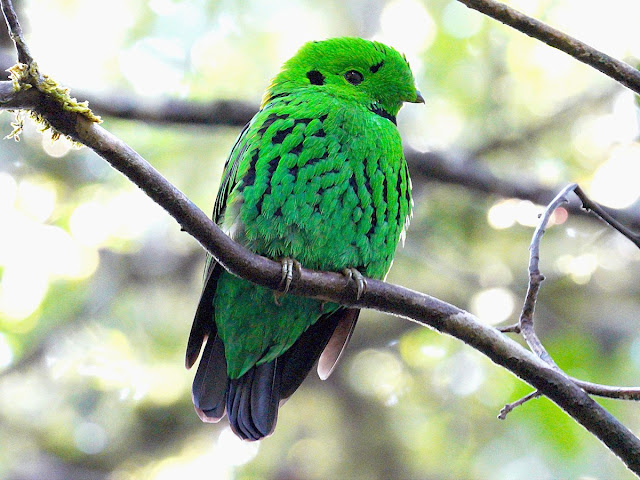 |
Whitehead’s Broadbill |
 |
| Whitehead’s Trogon |
We enjoyed the presence of the Trogon for the next fifteen minutes or so, at one point it caught a caterpillar and perched very close to us, giving phenomenal views that will surely be the highlight of the trip!
เราเพลิดเพลินกับการปรากฏตัวของ Trogon ประมาณสิบห้านาทีต่อจากนี้ มีอยู่ช่วงหนึ่งที่มันจับหนอนผีเสื้อและเกาะอยู่ใกล้เรามาก ทำให้เกิดทิวทัศน์อันน่าอัศจรรย์ซึ่งจะเป็นไฮไลท์ของการเดินทางอย่างแน่นอน!
หลังจากที่ Trogon ละลายกลับเข้าไปในป่า เราก็กลับไปที่ถนน Power Station และพบกับฝูงผสมอีกฝูงหนึ่ง ซึ่งประกอบด้วย Sunda Laughingthrush และ Chestnut -hooded Laughingthrush และแซงแซวหงอนขนก็ออกมาโชว์ได้ดีเช่นกันLater on a few Bornean Green Magpies came through and gave excellent views, one entertained us while it disassembled a cicada right above us.
ต่อมามีนกสาริกาเขียวบอร์เนียวสองสามตัวผ่านเข้ามาและให้ทัศนียภาพที่ยอดเยี่ยม มีตัวหนึ่งให้ความบันเทิงแก่เราในขณะที่มันกำลังแยกชิ้นส่วนจั๊กจั่นอยู่ด้านบนเราMoths that evening was not quite so exciting as previous evening, but still provided some after dinner fun. A beautiful Omiza lycoraria being the most interesting find of all.
มอธในเย็นวันนั้นไม่ค่อยน่าตื่นเต้นเท่าเย็นวันก่อน แต่ก็ยังสร้างความสนุกสนานหลังอาหารเย็นได้บ้าง Omiza lycoraria ที่สวยงามเป็นสิ่งที่น่าสนใจที่สุด3 - 7th May 2019
We again drove up to Timpohon Gate to start our day, a Sunda Cuckoo I presume to be the same bird as the day before was again near the same area, this time giving much better view without the mist. Bornean Treepies were again noisy and showed well. A few Golden-naped Barbets were again feeding in the fruiting tree. The best find was perhaps a Whitehead's Pygmy Squirrel which showed well at close range.
เราขับรถไปที่ Timpohon Gate อีกครั้งเพื่อเริ่มต้นวันใหม่ โดยมี Sunda Cuckoo ที่ฉันเดาไว้ว่าเป็นนกตัวเดียวกับวันก่อน แต่ก็อยู่ใกล้บริเวณเดียวกันอีกครั้ง คราวนี้ให้ทัศนียภาพที่ดีกว่ามากโดยไม่มีหมอก Bornean Treepie มีเสียงดังอีกครั้งและแสดงได้ดี Barbets สีทองสองสามตัวกำลังหากินอยู่บนต้นที่ออกผลอีกครั้ง การค้นพบที่ดีที่สุดอาจเป็นกระรอกแคระหัวขาวซึ่งแสดงได้ดีในระยะใกล้
ฉันยังคงพยายามหานกกระทาอกแดง ซึ่งในที่สุดฉันก็มองเห็นแวบหนึ่ง แต่พ่อของฉันไม่สามารถเรียกขึ้นมาได้ เราขับรถกลับลงไปที่ร้านอาหาร Liwagu ซึ่งมี Indigo Flycatcher โชว์อีกครั้ง เราตัดสินใจเดินตามเส้นทาง Silau-Silau อีกครั้ง เนื่องจากแม่พลาดทั้ง Trogon และ Broadbill เมื่อวันก่อน แน่นอนว่า นกปากกว้างของไวท์เฮดก็ปรากฏตัวอยู่ใกล้บริเวณเดียวกัน คราวนี้เกาะอยู่ได้นานเท่าที่เราต้องการ เมื่อเราออกจากเส้นทาง เราได้เจอกลุ่มนกจากปักกิ่ง เรายังได้ชี้จุดให้พวกเขาได้ดูในขณะที่มันอยู่ที่เดิมThings were dead quiet afterwards, so we decided to go for an early lunch at Ranau. Before we hit the road we stopped at the main entrance to look at the nests of Plume-toed Swiftlets. These swiftlets were once thought to be the endemic Bornean Swiftlets but had since been confirmed to be just Plume-toed. Bornean Swiftlets supposedly resides higher up, so it and the Friendly Bush Warbler maybe my next target here!
หลังจากนั้นสิ่งต่างๆ ก็เงียบลง เราจึงตัดสินใจไปทานอาหารกลางวันกันที่ Ranau ก่อนออกเดินทางเราแวะที่ทางเข้าหลักเพื่อดูรังของนกนางแอ่น Plume-toed Swiftlets นกแอ่นเหล่านี้เคยคิดว่าเป็นนกแอ่นบอร์เนียวประจำถิ่น แต่ได้รับการยืนยันแล้วว่าเป็นเพียงนกแอ่นปากขนนก นกนางแอ่นบอร์เนียวน่าจะอาศัยอยู่ชั้นบน ดังนั้นมันและนก Friendly Bush Warbler อาจเป็นเป้าหมายต่อไปของฉันที่นี่! |
| Friendly Bush Warbler |
After lunch and a good rest, we make our way back into the park, things were equally quiet. Few common birds showed well, a female Blyth's Shrike-Babbler in particular. Near the parking area of Timpohon Gate we saw two species of endemic squirrels, including Bornean Black-banded Squirrel and Bornean Mountain Ground Squirrel.
หลังจากรับประทานอาหารกลางวันและพักผ่อนอย่างเต็มที่ เราก็เดินทางกลับเข้าไปในสวนสาธารณะ สิ่งต่างๆ ก็เงียบสงบไม่แพ้กัน มีนกธรรมดาเพียงไม่กี่ตัวที่แสดงให้เห็นได้ดี โดยเฉพาะอย่างยิ่งBlyth’s Shrike-Babbler ตัวเมีย ใกล้กับบริเวณที่จอดรถของประตู Timpohon เราเห็นกระรอกประจำถิ่นสองสายพันธุ์ ได้แก่ กระรอกแถบดำบอร์เนียวและกระรอกดินภูเขาบอร์เนียวLower down the Power Station Road we had a Black-sided Flowerpecker, a species that was quite easy on my previous visits, where they will feed on the Medinella berries, this time I only saw them high up in the trees. A brief walk into the Silau-Silau trail was not particularly productive other than the same Whitehead's Broadbill AGAIN! A few Mountain Leaf Warblers were about the only birds photographable before dark.
 |
| Black-sided Flowerpecker, |
ด้านล่างของถนน Power Station เรามีนกหัวขวานสีดำ ซึ่งเป็นสายพันธุ์ที่ค่อนข้างง่ายในการมาเยือนครั้งก่อนของฉัน โดยพวกมันจะกินผลเบอร์รี่ Medinella คราวนี้ฉันเห็นพวกมันอยู่บนต้นไม้เท่านั้น การเดินสั้นๆ ไปตามเส้นทาง Silau-Silau นั้นไม่ได้ผลมากนัก ยกเว้น Broadbill ของ Whitehead อีกครั้ง! นกกระจิบใบไม้ภูเขาสองสามตัวเป็นนกเพียงชนิดเดียวที่สามารถถ่ายภาพได้ก่อนฟ้ามืดMothing was yet again quite productive that evening, with a Eupanacra psaltria hawk moth, Omiza herois and a Ischyja hemiphaea being highlights.
ผีเสื้อกลางคืนกลับมีประสิทธิผลค่อนข้างมากอีกครั้ง โดยมีผีเสื้อกลางคืน Eupanacra psaltria hawk, Omiza herois และ Ischyja hemiphaea เป็นจุดเด่น
Day 4 - 8th May 2019
Our last morning at Kinabalu National Park started with a pair of Orange-headed Thrush just before sun came out, it was still quite dark when the pair are out feeding by the roadside. A pair of Maroon Woodpeckers showed briefly.
เช้าวันสุดท้ายของเราที่อุทยานแห่งชาติคินาบาลูเริ่มต้นด้วยนก Thrush หัวส้มคู่หนึ่งก่อนพระอาทิตย์ขึ้น แต่ก็ยังค่อนข้างมืดเมื่อทั้งคู่ออกไปหาอาหารริมถนน นกหัวขวานมารูนคู่หนึ่งแสดงให้เห็นสั้นๆDown near Liwagu Restaurant, a few Bornean Green Magpies showed exceptionally well. We walked through Silau-Silau trail again, hoping to catch the Trogon before we leave but came up empty handed, the trail however was quite productive, giving us good views of Snowy-browed Flycatcher, Eyebrowed Jungle Flycatcher and Bornean Whistler.
ใกล้กับร้านอาหาร Liwagu นก Magpies สีเขียวบอร์เนียวสองสามตัวแสดงได้ดีมาก เราเดินผ่านเส้นทาง Silau-Silau อีกครั้ง โดยหวังว่าจะจับ Trogon ก่อนออกเดินทางแต่ก็กลับมามือเปล่า อย่างไรก็ตาม เส้นทางนี้ค่อนข้างมีประสิทธิผล ทำให้เราเห็นทิมุมที่ดีของ Flycatcher-browed Flycatcher, Eyebrowed Jungle Flycatcher และ Bornean Whistler
Snowy browed flycatcher

Eyebrowed junkle flycatcher
A Bornean Forktail gave us a glimpse before it fluttered off further up the stream. The same male Whitehead's Broadbill was found yet again on the exact same tree as the day before, by this time I suspect it is guarding a nest nearby, although I looked for the nest without much success. We also added a male White-browed Shortwing, although it was too quick for a photo, we had decent views of it.
นก Bornean Forktail ทำให้เราได้เห็นแวบหนึ่งก่อนที่มันจะกระพือปีกออกไปตามลำธาร นกพญาปากกว้างของไวท์เฮดตัวผู้ตัวเดิมถูกพบอีกครั้งบนต้นไม้ต้นเดียวกับเมื่อวันก่อน คราวนี้ฉันสงสัยว่ามันกำลังเฝ้ารังอยู่ใกล้ๆ แม้ว่าฉันจะมองหารังนั้นไม่ประสบผลสำเร็จมากนัก นอกจากนี้เรายังเพิ่ม White-browed Shortwingตัวผู้ แม้ว่าจะเร็วเกินไปสำหรับการถ่ายภาพ แต่เราก็มีมุมมองที่ดีBefore we left the park we had breakfast at the Liwagu Restaurant, where we saw a male Temminck's Sunbird, the pair of Indigo Flycatcher and a flock of Chestnut-crested Yuhina.
ก่อนออกจากสวนสาธารณะ เรารับประทานอาหารเช้าที่ร้านอาหาร Liwagu ซึ่งเราเห็นนก Sunbird ของ Temminck ตัวผู้ นก Indigo Flycatcher สองตัว และฝูง Chestnut-crested Yuhina.
เราเช็คเอาท์ก่อน 11.00 น. และเริ่มขับรถกลับไปที่โคตาคินาบาลู การจราจรค่อนข้างดี และเรามาถึงโรงแรมแชงกรี-ลา ตันจุง อารู เวลาประมาณ 13.30 น. รีสอร์ทแห่งนี้มีความสะดวกสบายเป็นอย่างมาก และเป็นทุกสิ่งทุกอย่างที่คุณสามารถจินตนาการได้จากโรงแรมริมทะเล พร้อมด้วยชายหาดส่วนตัว เราไม่กระตือรือร้นที่จะดูนกท่ามกลางอากาศร้อน ดังนั้นเราจึงพักผ่อนในห้องของเราAt around 4pm when the heat subsided, we saw a large flock of terns outside our window, my dad and I went out to investigate, to our surprise they were nearly all Little Terns! There were a few Whiskered Terns mixed in with the flock.
ประมาณ 16.00 น. เมื่อความร้อนลดลง เราเห็นฝูงนกนางนวลขนาดใหญ่อยู่นอกหน้าต่าง ฉันกับพ่อจึงออกไปสำรวจ เราแปลกใจมากที่พวกมันคือนกนางนวลตัวเล็กเกือบทั้งหมด! มีนกนางนวลเคราสองสามตัวปะปนอยู่กับฝูงThere were also a few Pacific Reef Egrets feeding in the shallows which put on quite a show for us. That evening we even added a Rufous Night Heron by the beach, although we were unable to get a photo of that, it was a great addition to our trip.
นอกจากนี้ยังมีนกกระยาง Pacific Reef สองสามตัวหากินในบริเวณน้ำตื้น ซึ่งถือเป็นการแสดงโชว์ให้เราดูมากทีเดียว เย็นวันนั้นเราได้เพิ่มนกกระสากลางคืนรูฟัสที่ชายหาดด้วย แม้ว่าเราจะไม่ได้ถ่ายรูปสิ่งนั้นไว้ แต่มันก็เป็นส่วนเสริมที่ดีสำหรับการเดินทางของเราThe incredible sunset at the resort was also an added bonus.
พระอาทิตย์ตกอันน่าทึ่งที่รีสอร์ทก็ถือเป็นโบนัสเพิ่มเติมเช่นกันDay 5 - 9th May 2019
Tanjung Aru Beach and nearby Taman Prince Philip is of course itself quite a decent birding spot, I've visited every time I come to Kota Kinabalu and it never seized to surprise me. The main attraction is no doubt the Blue-naped Parrot which are quite common in this area, although they supposedly introduced here, the fact that they are decreasing in their natural range in the Philippines make this feral population itself quite important. We saw plenty of these colourful parrots flying around the park.
หาด Tanjung Aru และ Taman Prince Philip ที่อยู่ใกล้เคียงนั้นแน่นอนว่าเป็นจุดดูนกที่ดีทีเดียว ฉันเคยไปมาทุกครั้งที่มาที่โคตาคินาบาลู และไม่เคยทำให้ฉันประหลาดใจเลย ไม่ต้องสงสัยเลยว่าแหล่งท่องเที่ยวหลักคือนกแก้ว Blue-naped Parrot ซึ่งค่อนข้างพบเห็นได้ทั่วไปในบริเวณนี้ แม้ว่าพวกมันควรจะแนะนำที่นี่ แต่ความจริงที่ว่าพวกมันกำลังลดขอบเขตการดำรงอยู่ตามธรรมชาติในฟิลิปปินส์ ทำให้จำนวนประชากรที่ดุร้ายนี้มีความสำคัญมาก เราเห็นนกแก้วหลากสีสันบินอยู่รอบๆ สวนมากมาย
The other parrot that is quite common here is the Long-tailed Parakeet, small flocks of these can be seen flying around and often feeding on palm fruits. We even caught a pair mating! Asian Glossy Starlings also seemed to like the palm fruits and we saw plenty feeding with the Parakeets.
นกแก้วอีกตัวที่พบได้ทั่วไปในที่นี้คือนกแก้วหางยาว ฝูงเล็กๆ เหล่านี้สามารถเห็นบินไปรอบๆ และมักจะกินผลปาล์ม เรายังจับคู่ผสมพันธุ์อีกด้วย! ดูเหมือนว่านกเอเชี่ยนโกลซี่สตาร์ลิ่งจะชอบผลปาล์ม และเราเห็นนกแก้วกินนกแก้วเป็นจำนวนมากCommon Ioras and Pied Trillers are both common birds here and not difficult to see. A few White-breasted Waterhens were seen along the edge of the park. Dollarbirds can be found perch on top of dead trees here in the park.
นกขมิ้นน้อยธรรมดาและ Pied Trillers เป็นนกทั่วไปที่นี่และมองเห็นได้ไม่ยาก มีกวักสองสามตัวปรากฏอยู่ตามขอบสวนสาธารณะ คุณสามารถพบ Dollarbirds เกาะอยู่บนต้นไม้ที่ตายแล้วในสวนสาธารณะแห่งนี้ |
| Pied Triller |
White-breasted Woodswallows are very common in the park, we saw a juvenile constantly begging for food up in the tree. Green Imperial Pigeons were hard to miss, I managed to find one sitting on a nest with a single chick! Pink-necked Green Pigeons are also very common here, although getting a good view is not always easy.
Later on the day we also added a Sunda Pygmy Woodpecker at the resort's car park. I did not have my camera with me, luckily my dad was carrying with him his Canon SX60 HS, which I managed a half decent shot of what was my closest encounter with this species to date!
In the afternoon we strolled around Kota Kinabalu, walking around a few of the tourist attractions, including the Atkinson Clock Tower, supposedly the oldest standing structure of Kota Kinabalu, built in 1905. We also strolled the famous Gaya Street and sampled many Malaysian food. This was actually the first time I walked around Kota Kinabalu city centre despite my many visits to the city!
We flew out of Kota Kinabalu very early the next day, as I was unable to get tickets for the afternoon flight. Overall, this trip was far more relaxed than my previous trips to Sabah, as this was aimed as a family/birding trip. Birds were not particularly active at Kinabalu National Park compared to my previous visit on the same month, perhaps something to do with the dry weather, but I am glad my main target Whitehead's Trogon showed up this time, together with unbelievable views of the Whitehead's Broadbill, I will say this short trip was well worth it.
For first time travellers I recommend a longer trip so you get more chances for the targets and endemics, although being such an accessible area it is not difficult to return once in a while to catch up with all the awesome species at Kinabalu National Park.
Field Guide used : 'Phillips' Field Guide to the Birds of Borneo' - third edition
Mobile Plan : You can get a one week 4G Plus plan at the airport for around 20RM
Car Rental : We used Extra Rent-a-Car, which I've used a few times already, staff are very friendly and they can pick up the car other than airport, I highly recommend them. website : http://www.e-erac-online.com/
Accommodation : For Kinabalu National Park we stayed at the Ayana Holiday Resort, which we booked through online, it is a fairly simple but nice little hotel, only a minute drive away from the park entrance. For Kota Kinabalu we stayed at Shangri-La Tanjung Aru, not a cheap hotel but worth the price and very comfortable, also very close to Taman Prince Philip therefore good for birding.
Posted by Matthew Kwan at 10:36
Day4
31 Mar 2024
Rainforest Discovery Centre
"Sabah’s Rainforest Discovery Centre (RDC) is regarded as one of the best environmental education centres in the state. Located within the most accessible natural rainforest in Sabah, the Kabili-Sepilok Forest Reserve, which is about 23 km away from Sandakan town, the RDC aims to provide visitors with the opportunity to experience nature up-close while educating them on the importance of rainforest conservation. "
The RDC includes an exhibition hall to provide a brief introduction to the various plant species available in the Kabili-Sepilok Forest Reserve, a Plant Discovery Garden, environmental education programmes, and a small lake.
The centre also provides a system of properly marked jungle trails, with plenty of signboards along the way, which enables visitors to navigate through the dense forest to observe nature via different paths.
Among the wildlife that can be seen there include civets, slow lorises, flying squirrels, tarsiers, mouse-deer, and orangutans, as well as several bird species that reside in the lower part of the tropical forest.
The RDC is also considered as one of the most diverse plant repositories in the country, showcasing a wide range of species, including pitcher plant and 250 types of orchids. Don’t forget to check out the Sepilok Giant, a yellow seraya tree, towering at 65 m and estimated to be 800 to 1,000 years old.
Besides that, the centre is also a bird watchers’ paradise. In fact, it is one of the biggest bird watching spots in Sabah and the venue for its annual Borneo Bird Festival, a unique event that attracts a lot of bird enthusiasts from all over the world.
A 347-m long and 25-m high steel canopy walkway system that leads visitors to the observation towers, provides an excellent spot for bird watchers to view over 300 bird species here, including both migratory and endemic bird species like rhinoceros hornbill, black-and-crimson pitta, crested jay, scarlet minivet, blue-headed pitta, and malkohas, just to name a few.
 |
| Crested Jay |
How to get there
The RDC is about 23 km from Sandakan town and just a stone's throw away from the Sepilok Rehabilitation Centre. Taxis are available, and many locals would know the exact location of this place.
The RDC is open daily from 8:00 am to 5:00 pm; however, the trails and canopy walkway will close at 8:00 pm. Entrance fees range from RM3 to RM15.
Day5
1 Apr 2024
เดินทาง167 km 3 hrs ไป Lahad Datu เช็คอิน
Bike and Tours Bed and Breakfast
เช้าวันที่2 เข้าชม Tabin wildlife reserve ทั้งวัน
Tabin Wildlife Reserve
Tabin is the largest reserve in Sabah and is bigger than Singapore in terms of land area. You can find most birds listed in the Sabah checklist here, and if you are into pittas, Tabin is also home to Bornean Banded Pitta, Black-crowned Pitta and Blue-headed Pitta.
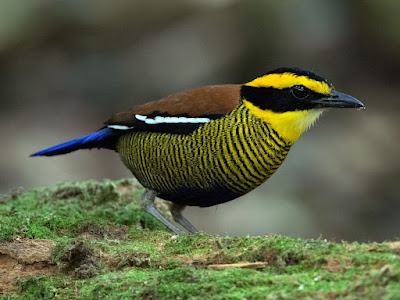 |
| Bornean Banded Pitta, |
 |
| Blue-headed Pitta. |
Inside the reserve there is only one accommodation, called the Tabin Wildlife Resort – a semi-luxurious resort catering to wildlife and nature lovers. Most birders will spend five to seven days here as the area is enormous. Attractions include primary and secondary forest zones and a salt lake and mud volcano. Visiting here during the fruiting season is the ultimate bonus for birding or photography.
ตาบินเป็นเขตสงวนที่ใหญ่ที่สุดในซาบาห์ และใหญ่กว่าสิงคโปร์ในแง่ของพื้นที่ คุณสามารถหานกส่วนใหญ่ได้ในลิตส์นกของรัฐซาบาห์ได้ที่นี่ และหากคุณชอบนกแต้วแล้ว Tabin ก็เป็นที่ตั้งของนกแต้วแล้วลายบอร์เนียว นกแต้วแล้วมงกุฎดำ และนกแต้วหัวสีฟ้า
ภายในเขตสงวนมีที่พักเพียงแห่งเดียวเรียกว่า Tabin Wildlife Resort ซึ่งเป็นรีสอร์ทกึ่งหรูหราที่จัดไว้สำหรับผู้รักสัตว์ป่าและธรรมชาติ นกส่วนใหญ่จะใช้เวลาห้าถึงเจ็ดวันที่นี่เนื่องจากพื้นที่มีขนาดใหญ่มาก สถานที่ท่องเที่ยว ได้แก่ โซนป่าปฐมภูมิและทุติยภูมิ ทะเลสาบน้ำเค็ม และภูเขาไฟโคลน การเยี่ยมชมที่นี่ในช่วงฤดูออกผลถือเป็นโบนัสขั้นสูงสุดสำหรับการดูนกหรือการถ่ายภาพ
Tabin is a bird-watcher’s paradise as the forest of Tabin attracts an amazingly rich diversity of birds, including rare and endemic species, due to the abundance of food plants here. The relatively low canopy with sufficient natural lights makes birding and photography a delightful experience.
Tabin เป็นสวรรค์ของนักดูนก เนื่องจากป่า Tabin ดึงดูดนกนานาพันธุ์อันอุดมสมบูรณ์อย่างน่าอัศจรรย์ รวมถึงนกหายากและพันธุ์เฉพาะถิ่น เนื่องจากมีพืชอาหารมากมายที่นี่ ร่มไม้ที่ค่อนข้างต่ำและมีแสงธรรมชาติเพียงพอทำให้การดูนกและการถ่ายภาพเป็นประสบการณ์ที่น่ารื่นรมย์
About 42 indigenous families representing more than 300 species have been recorded here including all the 8 of Sabah’s Hornbill species; Black Hornbill, Rhinoceros Hornbill, Wreathed Hornbill, Pied Hornbill, White-crowned Hornbill, Wrinkled Hornbill, Bushy-crested Hornbill and Helmeted Hornbill. Other sought-after species, such as the Blue-headed Pitta, Black-and-crimson Pitta, Malaysian Blue Flycatcher, Temminck’s Sunbird, Purple-throated Sunbird, Everett’s White-eye, Yellow-rumped Flowerpecker, and rarely seen species such as Storm’s Stork, Jambu Fruit Dove, Large Green Pigeon, White-fronted Falconet, Great-billed Heron and Giant Pitta have been sighted in Tabin.
 |
| Wreathed Hornbill |
 |
| Helmeted Hornbill. |

Giant pitta
มีการบันทึกชนิดพื้นเมืองประมาณ 42 ตระกูลที่เป็นตัวแทนของสายพันธุ์มากกว่า 300 สายพันธุ์ที่นี่ รวมถึงนกเงือกทั้ง 8 สายพันธุ์ของซาบาห์ด้วย นกเงือกดำ นกเงือกหัว แรด นกเงือกกรามช้าง นกแก๊ก นกเงือกหัวหงอก นกเงือกปากย่น นกเงือกปากดำ และนกเงือกชนหิน นกแต้วแล้วชนิดอื่นๆ ที่เป็นที่ต้องการ เช่น นกแต้วแล้วตัวสีน้ำเงิน นกแต้วแล้วสีแดงเข้ม นกจับแมลงสีน้ำเงินมาเลเซีย นกกินแมลง Temminck นกกินีคอสีม่วง นกตาขาวของเอเวอเรตต์ นกหัวขวานหางเหลือง และนกที่หายาก เช่น นกพายุ นกกระสา, นกพิราบผลไม้จัมบู, นกพิราบเขียวขนาดใหญ่, นกเหยี่ยวหน้าขาว, นกกระสาปากใหญ่ และนกแต้วแล้ว ได้รับการพบเห็นใน Tabin
Good Places For Bird Watching
Around The Resort
Explore the vicinity of the resort and you will be pleasantly surprised by the abundance of bird life found here. The Sunbird Café is wonderfully surrounded by greenery and flowering plants that attracts a number of brightly coloured birds. Sipping your coffee, your eyes will be kept busy following active species such as the Black-backed Kingfisher, Blue-eared Kingfisher, Yellow-rumped Flowerpecker, Red-throated Sunbird, Malaysian Blue Flycatcher, Large Green Pigeon, Dusky Broadbill and Black-and-Yellow Broadbill. Be entertained by the melodious calls of Black Magpie in the nearby ground.
A bird hide built facing the flowing Lipad River provides a wonderful site for the viewing of birds. Huge boulders in the river are favourite place for Oriental Darter, Stork-billed Kingfisher and Lesser Fish Eagle to perch especially after the rain. Happy families of Otters; Small-clawed Otter and Smooth-coated Otter have been seen up and down this part of the river and delights guests.
Take a stroll along the road nearby the resort. White-bellied Munia and Dusky Munia can be commonly found in the bushes. A family of Lesser Coucal sometimes make their appearances here. The rare Storm’s Storks have made Tabin their home and can sometimes be seen. You will most likely be able to see one or more of the eight species of hornbills in Borneo such as Black, White-crowned, Rhinoceros, Wreathed, Oriental Pied and Wrinkled Hornbills either flying in groups across the sky, or in pairs perching on bare branches. Let the guide share with you the tales and origins of the Helmeted Hornbill’s calls. สำรวจบริเวณใกล้เคียงรีสอร์ทแล้วคุณจะต้องประหลาดใจกับนกนานาชนิดที่พบได้ที่นี่ Sunbird Café ล้อมรอบด้วยต้นไม้เขียวขจีและไม้ดอกที่ดึงดูดนกสีสันสดใสจำนวนมาก ขณะจิบกาแฟ ดวงตาของคุณจะมัวแต่ยุ่งอยู่กับสัตว์ที่ตื่นตัว เช่น นกกระเต็นหลังดำ นกกระเต็นหูฟ้า นกหัวขวานหางเหลือง นกกินีคอแดง นกจับแมลงสีน้ำเงินมาเลเซีย นกพิราบเขียวขนาดใหญ่ นกปากกว้าง Dusky และนกปากดำและ -นกปากกว้างเหลือง เพลิดเพลินไปกับเสียงร้องอันไพเราะของ Black Magpie ในพื้นที่ใกล้เคียง
ลองนั่งบังไพรที่สร้างขนานไปตามแม่น้ำ Lipad ที่ไหลเชี่ยวเป็นสถานที่ที่ยอดเยี่ยมสำหรับการดูนก ก้อนหินขนาดใหญ่ในแม่น้ำเป็นสถานที่โปรดของ Oriental Darter, Kingfisher นกกระสา และ Lesser Fish Eagle ที่จะเกาะอยู่โดยเฉพาะหลังฝนตก ครอบครัวสุขสันต์ของนาก มีผู้พบเห็นนากเล็บเล็กและนากเคลือบเรียบขึ้นและลงแม่น้ำในส่วนนี้ และสร้างความเพลิดเพลินให้กับแขกเดินเล่นไปตามถนนใกล้ๆรีสอร์ท White-bellied Munia และDusky Munia สามารถพบได้ทั่วไปในพุ่มไม้ บางครั้งครอบครัวของ Lesser Coucal ก็มาปรากฏตัวที่นี่ นกกระสา Storm’s Storks หายากทำให้ทาบินเป็นบ้านของพวกมันและบางครั้งก็สามารถพบเห็นได้
คุณน่าจะมีโอกาสได้เห็นนกเงือก 1 ชนิดหรือมากกว่าจากทั้งหมด 8 สายพันธุ์ในเกาะบอร์เนียว เช่น นกเงือกดำ นกเงือกหัวหงอก นกเงือกกรามช้าง นกแก๊ก และนกเงือกปากย่น ไม่ว่าจะบินเป็นกลุ่มข้ามท้องฟ้า หรือเกาะเป็นคู่ ให้ไกด์เล่าเรื่องราวและต้นกำเนิดของเสียงเรียกของนกชนหินให้คุณฟัง
The Lipad Mud Volcano & Tomanggong Road
Tabin has several mud volcanoes and salt-water springs that are high in minerals of importance to wildlife. Frequently visited by animals and birds, the mud volcanoes are ideal locations to view wildlife or find evidence of their visits. Lipad mud volcano is the one nearest to the main base. The endemic Black-and-Crimson Pitta and Blue-headed Pitta has been sighted along the trail leading to the mud volcano. After jungle-trekked for twenty minutes, arrive at the elevated bare area of the mud volcano. Try to identify the multitude of animal footprints here. Those adventurous can experiment the effect of the volcanic mud said to be responsible for fine complexion. Walk up the observation tower and admire the contrasting landscape of the bare area and its surrounding thick forest.
Finsch’s Bulbul and Black-throated Wren-babblers, White-crowned Forktail, Dark-throated Oriole, Malaysian Blue Flycatcher are some species that can be seen around the area. A nearby fig-tree is a busy feasting place for hornbills and other birds and primates during the fruiting season. Across the observation tower, bare branches of towering trees are favourite perching place for Green Imperial Pigeon, Large Green Pigeon and Jambu Fruit Dove with its wonderful coloured chest.
Strolling along the Tomanggong Road is likely to yield a superb bird list. The Giant Pitta has been sighted along this road. The White-fronted Falconet, Long-tailed Parakeet and Orange-backed Woodpecker as well as other good birds, Red-naped Trogon, Yellow-rumped Flowerpecker may be sighted. You will most likely be able to observe Long-tailed Macaque and Orang-Utang along this road.

Red-naped Trogon,

Yellow-rumped Flowerpecker
ภูเขาไฟโคลนลิปัด และถนนโตมังกองTabin มภูเขาไฟโคลนและน้ำพุน้ำเค็มหลายแห่งซึ่งมีแร่ธาตุที่มีความสำคัญต่อสัตว์ป่าสูง สัตว์และนกมักมาเยือน ภูเขาไฟโคลนเป็นสถานที่ที่เหมาะสำหรับการชมสัตว์ป่าหรือค้นหาหลักฐานการมาเยือนของพวกมัน ภูเขาไฟโคลนลิปัดเป็นภูเขาไฟที่อยู่ใกล้ฐานหลักมากที่สุด มีผู้พบเห็นนกแต้วแล้วสีแดงเข้มและนกแต้วแล้วสีน้ำเงินประจำถิ่นตามเส้นทางที่นำไปสู่ภูเขาไฟโคลน หลังจากเดินป่าเป็นเวลายี่สิบนาที ก็มาถึงบริเวณพื้นที่โล่งของภูเขาไฟโคลน ลองระบุรอยเท้าสัตว์จำนวนมากที่นี่ นักผจญภัยเหล่านั้นสามารถทดลองผลของโคลนภูเขาไฟที่กล่าวกันว่ามีส่วนทำให้ผิวสวย เดินขึ้นไปบนหอสังเกตการณ์และชื่นชมภูมิทัศน์ที่ตัดกันของพื้นที่โล่งและป่าหนาทึบโดยรอบ
Finsch’s Bulbul and Black-throated Wren-babblers, White-crowned Forktail, Dark-throated Oriole, Malaysian Blue Flycatcher เป็นนกบางชนิดที่สามารถพบเห็นได้ทั่วบริเวณ ต้นมะเดื่อในบริเวณใกล้เคียงเป็นสถานที่เลี้ยงนกเงือก นกอื่นๆ และสัตว์เลี้ยงลูกด้วยนมในช่วงฤดูออกผลอันพลุกพล่าน ข้ามหอสังเกตการณ์ กิ่งก้านเปลือยของต้นไม้สูงตระหง่านเป็นสถานที่ยอดนิยมสำหรับ Green Imperial Pigeon, Large Green Pigeon and Jambu Fruit Dove ที่มีหน้าอกสีสวยงาม
การเดินเล่นไปตามถนนโตมังกองน่าจะได้รายชื่อนกที่ยอดเยี่ยม มีผู้พบเห็นนกแต้วแล้วยักษ์ตามถนนสายนี้ นกเหยี่ยวหน้าขาว นกนกแก้วหางยาว นกหัวขวานหลังส้ม ตลอดจนนกดีๆ อื่นๆ นกขุนแผนท้ายทอยแดง Yellow-rumped flowerpecker
คุณมักจะสามารถสังเกตลิงแสมและลิงอุรังอุตังได้ตามถนนสายนี้
Orange-backed woodpecker


Finsch’s Bulbul and Black-throated Wren-babblers, White-crowned Forktail, Dark-throated Oriole, Malaysian Blue Flycatcher เป็นนกบางชนิดที่สามารถพบเห็นได้ทั่วบริเวณ ต้นมะเดื่อในบริเวณใกล้เคียงเป็นสถานที่เลี้ยงนกเงือก นกอื่นๆ และสัตว์เลี้ยงลูกด้วยนมในช่วงฤดูออกผลอันพลุกพล่าน ข้ามหอสังเกตการณ์ กิ่งก้านเปลือยของต้นไม้สูงตระหง่านเป็นสถานที่ยอดนิยมสำหรับ Green Imperial Pigeon, Large Green Pigeon and Jambu Fruit Dove ที่มีหน้าอกสีสวยงาม การเดินเล่นไปตามถนนโตมังกองน่าจะได้รายชื่อนกที่ยอดเยี่ยม มีผู้พบเห็นนกแต้วแล้วยักษ์ตามถนนสายนี้ นกเหยี่ยวหน้าขาว นกนกแก้วหางยาว นกหัวขวานหลังส้ม ตลอดจนนกดีๆ อื่นๆ นกขุนแผนท้ายทอยแดง Yellow-rumped flowerpecker
คุณมักจะสามารถสังเกตลิงแสมและลิงอุรังอุตังได้ตามถนนสายนี้
Orange-backed woodpecker
Road To The Core Area
The Core Area lies in the heart of Tabin Reserve. Walking along the initial stretch of the road leading to the core area, you are likely to be entertained by wild bird songs and the calls of Borneon Gibbons. On some bare tree trunks, busy Dollarbird can be found along with Rufous Woodpecker, Bronzed Drongo, Blue-crowned Hanging Parrot, Speckled Piculet, Chestnut-capped Thrush, White-fronted Falconet, Long-tailed Parakeet, Black Eagle, Black Magpie and are some of the species that can be seen. The abundance of wild ginger plant attracts colourful varieties of birds, including the Orange-bellied Flowerpecker, Temminck’s Sunbird, Purple-throated Sunbird, Red-throated Sunbird, Thick-billed Spiderhunter, Grey-and-Buff Woodpecker and many others. This road would also be the best place to look for the very rare Bornean Bristlehead
ถนนสู่พื้นที่หลัก
พื้นที่หลักตั้งอยู่ในใจกลางเขตอนุรักษ์ทาบิน เมื่อเดินไปตามถนนสายแรกซึ่งนำไปสู่พื้นที่หลัก คุณจะมีโอกาสได้รับความบันเทิงจากเสียงเพลงของนกป่าและเสียงร้องของชะนีบอร์เนียว บนลำต้นของต้นไม้เปลือยบางชนิด สามารถพบ Dollarbird ที่พลุกพล่านได้พร้อมกับ Rufous Woodpecker, Bronzed Drongo, Blue-crowned Hanging Parrot, Speckled Piculet, Chestnut-capped Thrush, White-fronted Falconet, Long-tailed Parakeet, Black Eagle, Black Magpie และ บางชนิดที่สามารถมองเห็นได้ ความอุดมสมบูรณ์ของต้นขิงป่าดึงดูดนกหลากสีสัน เช่น นกหัวขวานท้องส้ม นกกินแมลง Temminck นกกินปลวกคอสีม่วง นกกินปลวกคอแดง นกนักล่าแมงมุมปากหนา นกหัวขวานสีเทาและควาย และอื่นๆ อีกมากมาย ถนนสายนี้ยังเป็นสถานที่ที่ดีที่สุดในการค้นหาสัตว์หายากชนิด Bornean Bristlehead
Observation hide for BB pitta
Unique-looking pitta of hill and submontane forests. Note bright red underparts, dull tan-orange face, dull blue-green back, and glittering silver-blue “necklace” and secondaries (similarly-colored line trailing down from behind the eye can be visible if seen well). Favors patches of forest with some disturbance, especially bamboo groves and fallen trees. Shy and elusive. Gives a whistle with a clipped ending; higher and more “fluty” than that of Black-crowned Pitta, and lacks the rising quality of that species’ and Garnet Pitta’s whistles.
ขับรถ 5.30 ชั่วโมง พักค้างคืนที่ The Elopura Hotel , Sandakan























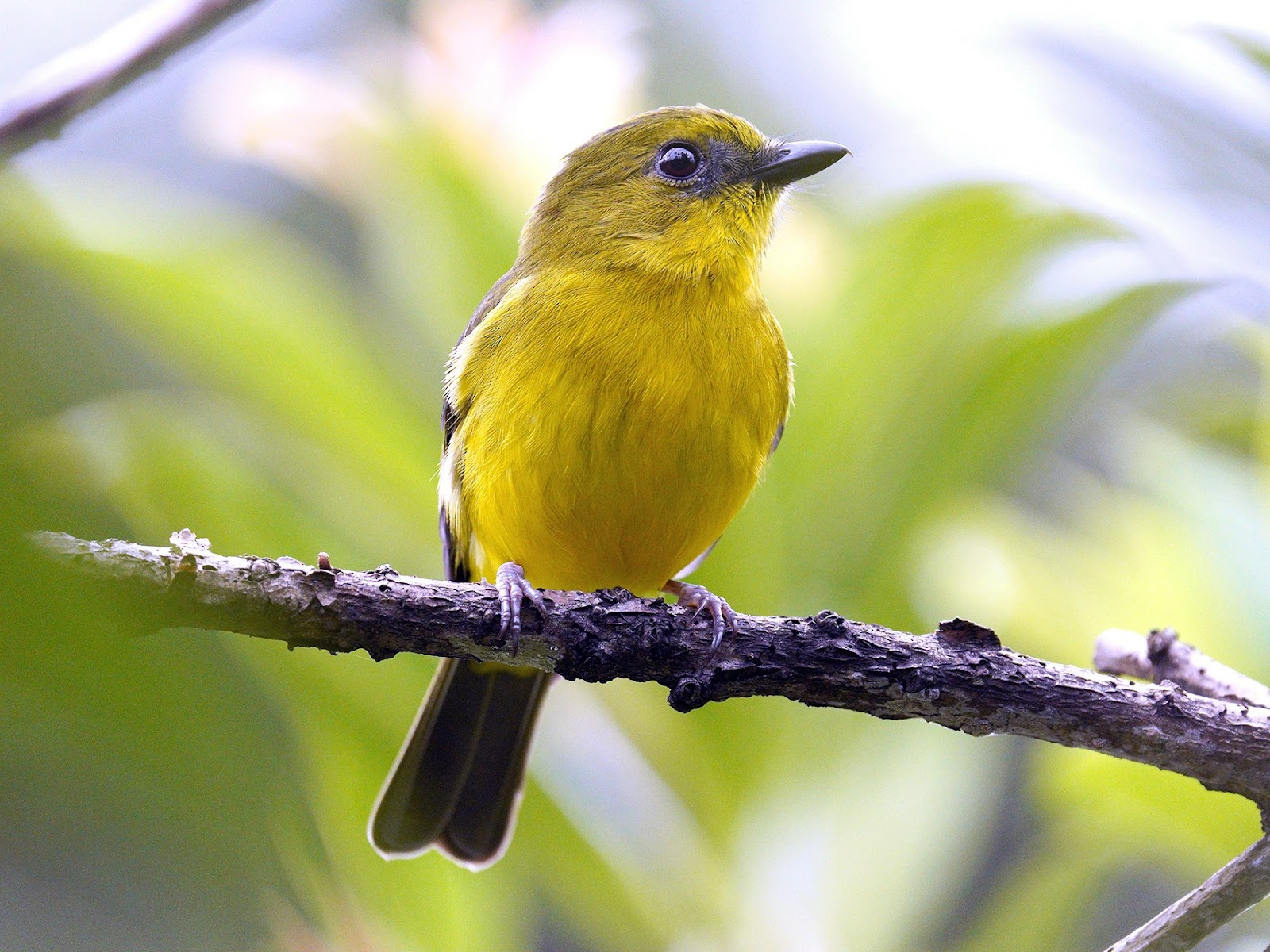







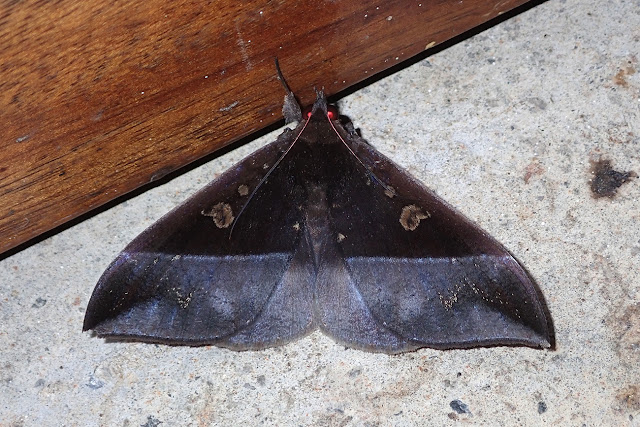


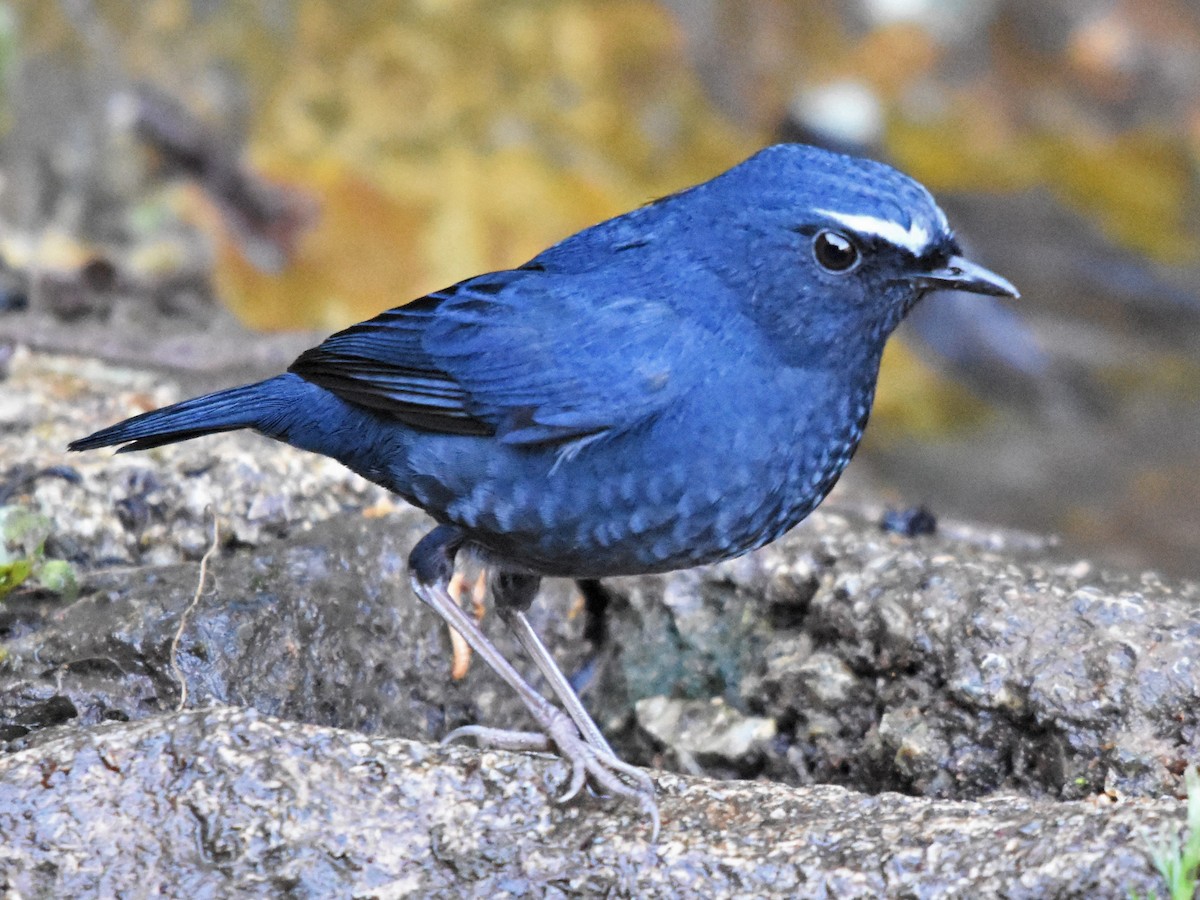













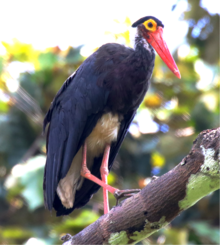











ไม่มีความคิดเห็น:
แสดงความคิดเห็น